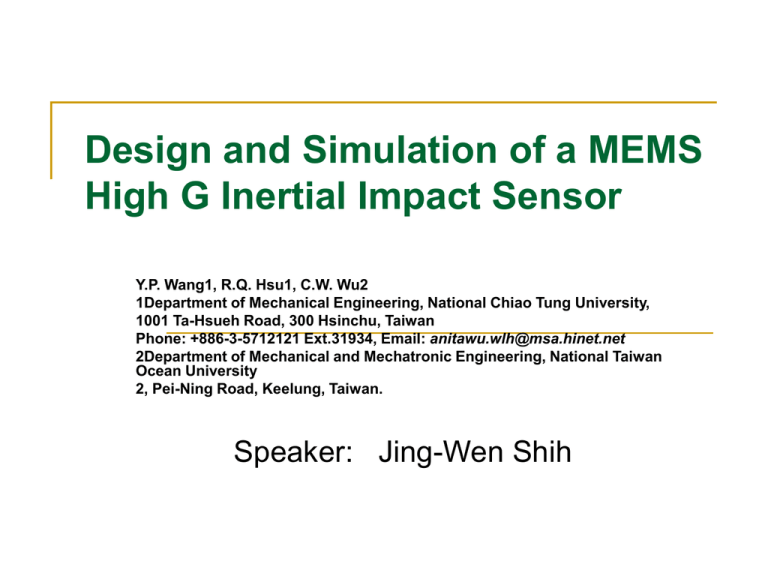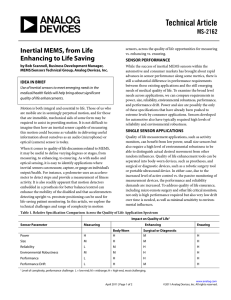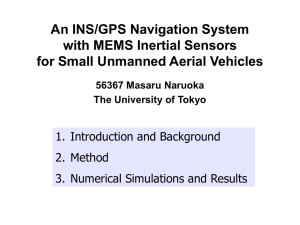981130_01
advertisement

Design and Simulation of a MEMS High G Inertial Impact Sensor Y.P. Wang1, R.Q. Hsu1, C.W. Wu2 1Department of Mechanical Engineering, National Chiao Tung University, 1001 Ta-Hsueh Road, 300 Hsinchu, Taiwan Phone: +886-3-5712121 Ext.31934, Email: anitawu.wlh@msa.hinet.net 2Department of Mechanical and Mechatronic Engineering, National Taiwan Ocean University 2, Pei-Ning Road, Keelung, Taiwan. Speaker: Jing-Wen Shih Outline Introduction The major goal of Inertial impact sensor The micro impact sensor proposed in this study Simulation Conclusion Reference Introduction Inertial sensors have been extensively utilized in science like inertial navigation systems and airbag triggers . For high G(>300G) applications. Reaction times for conventional mechanical type impact sensors are not fast enough. The major goal of inertial impact sensor Designing an impact sensor that has a faster reaction time than conventional sensors and a mechanism that is sufficiently robust to survive the impact when a vehicle collides with a hard target is the major goal of this study. Conventional inertial impact sensor (a)cantilever beam type (b)axial spring type MDS System trigger MDS: Mass- Damper- Spring Dynamic Proof mass expressed by dynamic equation lamped system: Use Laplace transformation to the second – order function for acceleration mass: The micro impact sensor proposed in this study To evaluate system reaction time, 4 different arrangements of spring and proof mass were tested. The proof mass scale and coil number of the sensor Simulation Displacement versus applied forces for each sensor The response time of the microsensor Proof mass increases from 0.62 to 1.0, and the spring constant remains unchanged, the reaction time is decreased. Minimum G values for the sensors to be triggered Reducing the spring constant, and retaining the proof mass, the reaction time decreased and the trigger G value decreased for sensors Minimum G values for the sensors to be triggered The plastic strain of the type 1 sensor in 21000G With no significant interference in the x and z axis; consequently,sensor stability is very good. Conclusion This proposed impact sensor is intended for use at 8,000–21,000G. Four different designs were analyzed. The impact sensors were sufficiently robust to survive the impact of at least 21,000G, four times higher than that of conventional inertial impact sensors. References F. Goodeough, Airbag boom when IC accelerometer sees 50 G,Electronics Design, pp.45-56, August. 8, 1991. Tadao Matsunaga, Masayoshi Esashi, Acceleration switch with extended holding time using squeeze film effect for side airbag systems, Sensors and Actuators A:physical, vol. 100, Issue 1, pp.1017 , August. 2002. Military Standard, Mechanical Shock Test, MIL-STD-883E Method 2002.4, US Dept. of Defense, 2004. Donald R. Ask eland, The science and engineering of materials, 1st edn,Taipei, Kai Fa, 1985, ch. 6, pp. 126-127. Trimmer, W.S.N, Microrobots and Micromechanical Systems, Sensors and Actuators vol.19 no.3, pp. 267-287, 1989. M. Elwenspoek, R. Wiegerink, Mechanical Microsensors, Germany,Springer, 2001. Tai-Ran Hsu, MEMS & Microsystems Design and Manufacture,international edition 2002, Singapore, McGraw-Hill, pp. 157-159. Thanks for your attention











